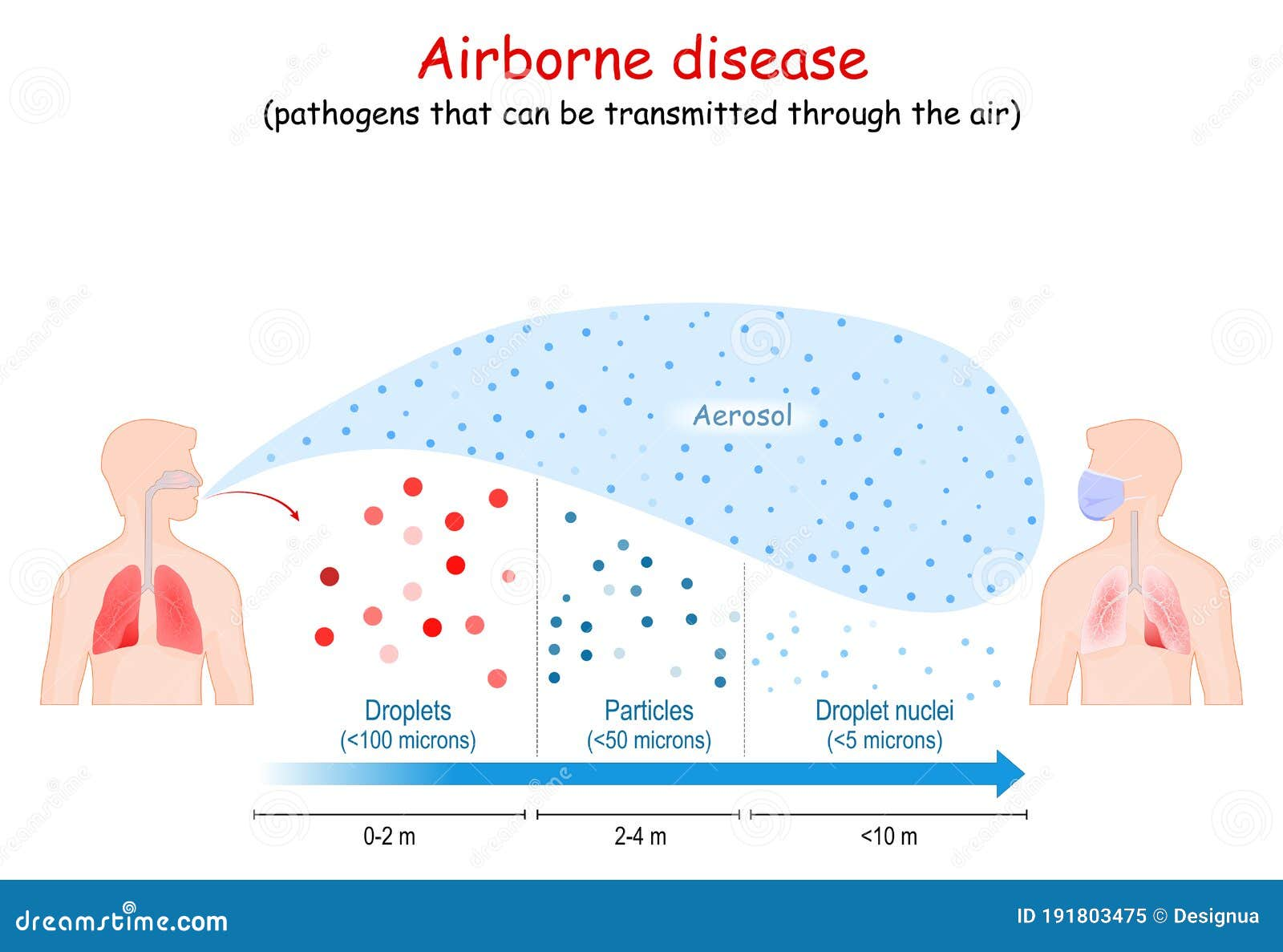Airborne diseases pose a significant challenge to public health, as pathogens transmitted through the air can lead to widespread infections and outbreaks. Renowned science writer Carl Zimmer highlights the historical struggles associated with understanding the airborne infection theory, an evolution of the germ theory of disease, which has been instrumental in shaping our approach to these illnesses. Early researchers like William Firth Wells made critical advancements in recognizing how microbes can spread through the air, yet their findings were often overshadowed by personal struggles and societal skepticism. Through rigorous public health research, scientists have gradually unveiled the complexities of airborne infections, revealing how easily they can propagate in crowded environments. As awareness of these diseases increases, understanding their transmission becomes essential in managing outbreaks and protecting communities worldwide.
Infectious diseases that spread through the air, often referred to as airborne pathogens, represent a critical area of study for health professionals and researchers alike. These airborne illnesses can manifest rapidly, particularly in populous settings, where droplets carrying viruses and bacteria can easily be inhaled by nearby individuals. Renowned figures in science, such as Carl Zimmer, have discussed the evolution of our understanding of airborne transmission, illustrating the transition from antiquated beliefs to the modern recognition of airborne infection theory. Knowledge surrounding these infections is vital, especially in light of recent global health crises, where effective public health measures depend on our comprehension of how such maladies propagate through the atmosphere. As advancements in research continue, the goal remains clear: to develop effective strategies that curb the spread of airborne diseases and safeguard public health.
The Influence of Personalities on Scientific Progress
The impact of a scientist’s personality on the advancement of their field is often overlooked. In the case of William Firth Wells, Carl Zimmer argues that his socially awkward demeanor and inability to engage effectively with peers may have significantly hindered the acceptance of his groundbreaking research on airborne diseases. This scenario exemplifies the concept of the ‘Great Man’ theory, which suggests that individual characteristics can either catalyze or impede scientific discovery. While extraordinary personalities are frequently credited with making significant strides in their respective domains, the reverse can be true, particularly for those like Wells, whose lack of charisma may have caused a detrimental effect on their work’s reception.
Moreover, as science progresses, the necessity for clear and communicative discourse becomes crucial. Researchers need to contextualize their findings within the broader landscape of existing knowledge, which invariably requires persuasion and articulation skills. The importance of this was evident in Wells’s career, where his findings on airborne pathogens and their transmission were overshadowed by his ineffective communication. Although Wells contributed to advancing public health research, his inability to convey critical messages about airborne infection may have stalled essential policies and interventions that could have saved lives.
Airborne Diseases: Historical Perspectives and Modern Implications
The historical understanding of airborne diseases has evolved significantly over time. From the ancient Greeks’ miasma theory to the germ theory of disease championed by figures like Louis Pasteur, societal perceptions about how diseases spread have dramatically shifted. Carl Zimmer’s exploration highlights how resistance to accepting the role of air as a medium for disease transmission delayed public health responses, even during critical outbreaks like cholera in the 1830s. Understanding how bacteria and viruses can be disseminated through the air is pivotal not just for scientific perspectives, but for public policy and the management of epidemics.
In contemporary settings, the implications of understanding airborne diseases have never been more relevant, especially in the wake of global health crises like COVID-19. Zimmer emphasizes that grasping the mechanics of airborne infections is vital for developing effective preventive measures, such as ventilation strategies and public health policies. As scientists continue to unravel the complexities of airborne pathogens, their work underscores the need for an informed public that can appreciate the nuances of health risks associated with air quality. The lessons learned from the past, including those illuminating Wells’s contributions, continue to inform today’s research and response strategies.
The Role of Public Health Research in Accepting New Science
Public health research plays a crucial role in transforming scientific theories into accepted practices that shape health management strategies. Carl Zimmer’s discussion about William Firth Wells sheds light on how pioneering studies, despite their significance, can be overlooked due to external factors such as the researcher’s character. For instance, Wells’s investigations into airborne infection theory and the effectiveness of ultraviolet light in eradicating airborne pathogens are pivotal findings that ideally would influence public health protocols. However, the failure to embrace these theories underscores the need for a robust system of dissemination and advocacy within the scientific community.
Furthermore, effective public health research must actively engage with the community to educate and inform about advancements that could protect populations from airborne diseases. Like Wells’s challenges, contemporary researchers face hurdles in gaining acceptance for new findings, making it imperative to disseminate information clearly and effectively. Public engagement initiatives, potentially characterized by charismatic communication, can bridge the gap between scientific discovery and societal readiness to adopt new health measures. Emphasizing clear communication in conjunction with rigorous scientific inquiry will enable a more proactive approach to managing airborne illnesses and fostering a healthier society.
Lessons from Historical Figures in Scientific Research
Studying figures like William Firth Wells offers valuable insights into the challenges that shaped the field of airborne disease research. Although his contributions were significant, Wells’s personal shortcomings and the inability to effectively communicate his findings to peers left a void that hampered progress. Carl Zimmer illuminates the need to reflect upon how personalities influence the advancement of science, as these elements can potentially stifle remarkable discoveries. This calls for a re-evaluation of how we perceive and support scientists, ensuring that their work gains the recognition it deserves, irrespective of their social skills.
Through the lens of Wells’s experiences, contemporary researchers could benefit from lessons about resilience and the importance of advocacy in the face of scientific neglect. It has become increasingly evident that historical context and personal narratives should accompany scientific achievements for society to fully appreciate their implications. Understanding the stigma or biases that might accompany a scientist’s approach enhances our comprehension of their discoveries and the methodologies involved, fostering an environment where future research on airborne diseases can flourish without the consequences of an individual scientist’s shortcomings.
Advances in Airborne Pathogen Research
Recent advances in research on airborne pathogens have highlighted the critical need for innovative solutions to combat the spread of diseases transmitted through the air. The research breakthroughs made by scientists like William Wells, albeit overshadowed at times, have laid the groundwork for modern studies aimed at understanding and mitigating the risks associated with airborne infection. With technological advancements and refined methodologies, today’s researchers can conduct extensive epidemiological studies to recognize patterns and develop strategies to prevent outbreaks.
Moreover, the application of new technologies, such as advanced air filtration systems and UV-light sterilization methods, directly stems from the foundational work in airborne transmission laid out by early researchers. Today’s public health policies increasingly reflect these advances, emphasizing the importance of air quality and ventilation in settings like schools and hospitals. As we continue to enhance our understanding of airborne diseases, it is essential to remember the contributions of early scientists and utilize their findings to further public health measures effectively.
The Importance of Historical Context in Science
Understanding the historical context of scientific discoveries is essential for grasping the current state of research. Zimmer’s exploration of the lives and work of scientists like William Firth Wells underscores the intricate relationship between scientific ideas and the cultural or institutional frameworks in which they are situated. In particular, societal hesitations toward accepting the concept of airborne diseases not only delayed Wells’s work but also created a lag in public health advancements that could have benefited earlier from his findings.
This examination of past scientific transformations illustrates the necessity for contemporary researchers to be aware of historical biases and challenges they might encounter in their efforts to communicate new ideas. The incorporation of history into scientific discourse cultivates an appreciation for the evolution of knowledge, enabling present-day researchers to navigate obstacles associated with public acceptance, particularly in matters concerning airborne disease transmission. Such awareness equips them with strategies to disseminate their findings more effectively, fostering an environment conducive to innovation and progressive thinking.
Challenging the Norms of Scientific Communication
The challenges faced by William Firth Wells in communicating his findings about airborne pathogens reflect broader issues in scientific communication today. Carl Zimmer’s narrative suggests that effective communication not only hinges on the data but also on the researchers’ ability to convey their message compellingly. As we strive to communicate the importance of research on airborne diseases, we must consider how personality traits and engagement strategies impact the effectiveness of our outreach.
Developing captivating narratives around scientific findings is essential for fostering greater public understanding and acceptance. By learning from Wells’ challenges, modern scientists can harness various communication platforms to engage diverse audiences, allowing them to better appreciate the implications of their research. Creating clear and relatable messages surrounding the impact of airborne infections can significantly contribute to promoting proactive health measures and elevating community awareness regarding the importance of air quality and health.
Impacts of War on Scientific Research
Historically, periods of conflict, such as World War II, have influenced scientific research trajectories, often redirecting focus and resources toward military applications. In Wells’ case, his groundbreaking research on airborne diseases faced setbacks during these turbulent times, as military needs overshadowed public health research. Carl Zimmer highlights how scientists, like Wells, often find themselves sidelined due to shifts in funding priorities and institutional support, which can significantly impact the advancement of their research.
Post-war periods often provide unique opportunities for the integration of scientific advancements into public health initiatives, as demonstrated by Wells’s later collaborations with military researchers. However, the scientific community must remain vigilant to ensure that crucial public health research, especially in airborne diseases, does not become relegated in favor of immediate military applications. A conscious effort to prioritize such research will safeguard against the potential loss of valuable contributions that could enhance community health outcomes.
The Future of Airborne Infectious Disease Management
Looking ahead, the future of airborne infectious disease management relies on continued innovation and interdisciplinary collaboration. Carl Zimmer’s discussion around Wells and the evolution of the airborne infection theory underscores a critical need to harness contemporary data science, epidemiology, and public health practice to create robust systems of disease prevention. Embracing advanced technologies for air quality monitoring and pathogen detection will play a pivotal role in shaping effective strategies for managing airborne health risks.
Moreover, fostering a culture of transparency and education within scientific circles and the public sphere is essential to address misconceptions about how airborne diseases spread. By drawing upon insights from historical and current research, stakeholders can implement more effective health policies that prioritize public understanding of airborne pathogens. Enhancing awareness through community engagement will empower individuals to take proactive measures to safeguard their health, paving the way for a healthier future.
Frequently Asked Questions
What are airborne diseases and how are they spread?
Airborne diseases are illnesses caused by pathogens that are transmitted through the air. These pathogens, such as viruses and bacteria, can become aerosolized and inhaled, leading to infection. Key research by figures like William Firth Wells has demonstrated that airborne infection theory indicates that even exhalations can carry infectious agents, highlighting the importance of air quality in public health.
How did Carl Zimmer contribute to the understanding of airborne diseases?
Carl Zimmer, through his book ‘Air-Borne: The Hidden History of the Life We Breathe,’ explores the concept of airborne diseases and the work of researchers like William Firth Wells. His contributions help make complex theories like the airborne infection theory more accessible, emphasizing how historical misunderstandings, including those stemming from the germ theory of disease, have shaped public health responses.
What is the significance of the airborne infection theory in public health research?
The airborne infection theory is crucial in public health research as it explains how many infectious diseases can be transmitted through the air. This theory, advanced by scientists like Wells, has led to significant advancements in controlling diseases such as tuberculosis and measles, ultimately improving health outcomes by focusing on ventilation and air quality.
How did historical perceptions of air and disease influence public health policies?
Historically, many diseases were not linked to the air, despite early theories like miasmas suggesting a connection. Influential figures such as Carl Zimmer and research stemming from the germ theory of disease began to shift this perspective, leading to the recognition of airborne diseases and influencing public health policies to include air quality measures.
What role did William Firth Wells play in the development of airborne disease research?
William Firth Wells was instrumental in developing the airborne infection theory by proving that pathogens could be spread through the air. His innovative experiments in controlled environments revealed how airborne diseases could infect individuals, thus laying vital groundwork for modern public health approaches to managing such infections.
Why is the story of Williams Firth Wells important for understanding airborne diseases today?
The story of William Firth Wells is significant because it highlights the challenges and breakthroughs in understanding airborne diseases. His struggles for recognition amid personal and professional obstacles reflect the complexities in science and public perception that continue to affect how airborne diseases are addressed in contemporary public health research.
| Key Points | Details |
|---|---|
| Carl Zimmer’s Hypothesis | Carl Zimmer theorizes that the personality of key researchers in airborne disease control has hindered progress. |
| The Legacy of Wells | William Firth Wells’ work was groundbreaking but marred by personality issues that affected collaboration and funding. |
| Historical Context | Airborne diseases were historically overlooked due to ancient theories like miasmas and later scientific hesitance regarding air transmission. |
| Significant Discoveries | Wells demonstrated that airborne pathogens could spread diseases and could be neutralized by ultraviolet light. |
| Career Struggles | Wells faced multiple disputes and setbacks that limited the acceptance of his research amid attempts to validate his findings. |
| Impact on Future Research | Zimmer expresses concern that current research may be stunted by similar personality dynamics as experienced by researchers like Wells. |
Summary
Airborne diseases have been a critical focus in public health due to their potential for widespread transmission. In his exploration of this topic, Carl Zimmer emphasizes how the personality traits of researchers, particularly William Wells, may have stymied breakthroughs in understanding and controlling these diseases. Despite significant discoveries confirming that diseases can be transmitted through the air, societal and institutional challenges have often overshadowed these findings. As we move forward, the lessons from past researchers highlight the need to advocate for collaborative environments in scientific research, ensuring that such groundbreaking work receives the recognition it deserves.



